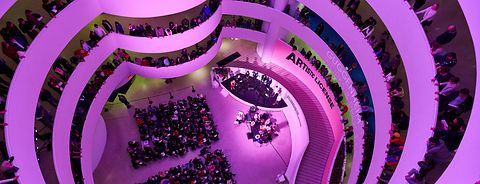Please explain in short the background of the Guggenheim Rotunda Project. What was the intention behind it?
I have had the great pleasure of working closely with Works & Process at the Guggenheim for the past 10 years. This is an incredible organization that brings together like minded artists from a wide range of artistic disciplines to create new and exciting work specifically for the Guggenheim Museum’s Peter B. Lewis Theater and the iconic Frank Lloyd Wright Rotunda. Performances in the rotunda range from site specific dance performances to diverse opera engagements.
Tell us about the project, environment, and the general lighting requirements?
For this rotunda concert series I had to design a flexible light plot that could be hung, focused, and cued in one hour. This was a live concert with dancers, musicians, and vocalists using the entire 360º rotunda, so there Is a lot of performance space to cover. There was no time for a dress or tech rehearsal for this project, so all of my design ideas had to be roughly pre-programmed in the console prior to our load in. The entire show was essentially designed “live” in front of the audience while the performance was taking place. This allowed me to create an extremely organic and impulsive experience as a designer. The entire experience felt like painting with light in an active art gallery. Since the Guggenheim Museum is open to the public during the day, the load in and focus could not begin until the museum was officially closed to the public.
Did the architecture of the building present special challenges in terms of lighting?
Lighting the iconic Guggenheim Rotunda is not only a dream come true for me as a designer but also an enormous responsibility. For this project, I like to think that the major collaboration was between myself and the incredible Frank Lloyd Wright architecture. Having the opportunity to transform the way we view this space was a thrilling experience.
When lighting a performance in the rotunda, the architecture, power requirements, exhibit rules, and paintings are important details to consider. What made this a unique challenge is that the lighting must avoid illuminating the artwork in the exhibit. For this reason, all of the lighting was bounced directly off the ceiling to indirectly light the white walls, white floor, and ramps that surround the entire rotunda. It created a really beautiful otherworldly experience that directly matched the music and choreography.
Why did you decide to use the SkyPanel 360-C?
For this project It was important to find a fixture that was user friendly, color efficient, extremely bright, and easy to setup in a short amount of time. What I love so much about the SkyPanel series is that these fixtures produce a gorgeous and beautiful quality of light that is truly larger than life. When working in a space like the Guggenheim Museum, the lighting must match this scale and I knew immediately that the only fixture I could trust for this important application was the SkyPanel 360. I am also a huge fan of the extremely soft edge of this fixture.




